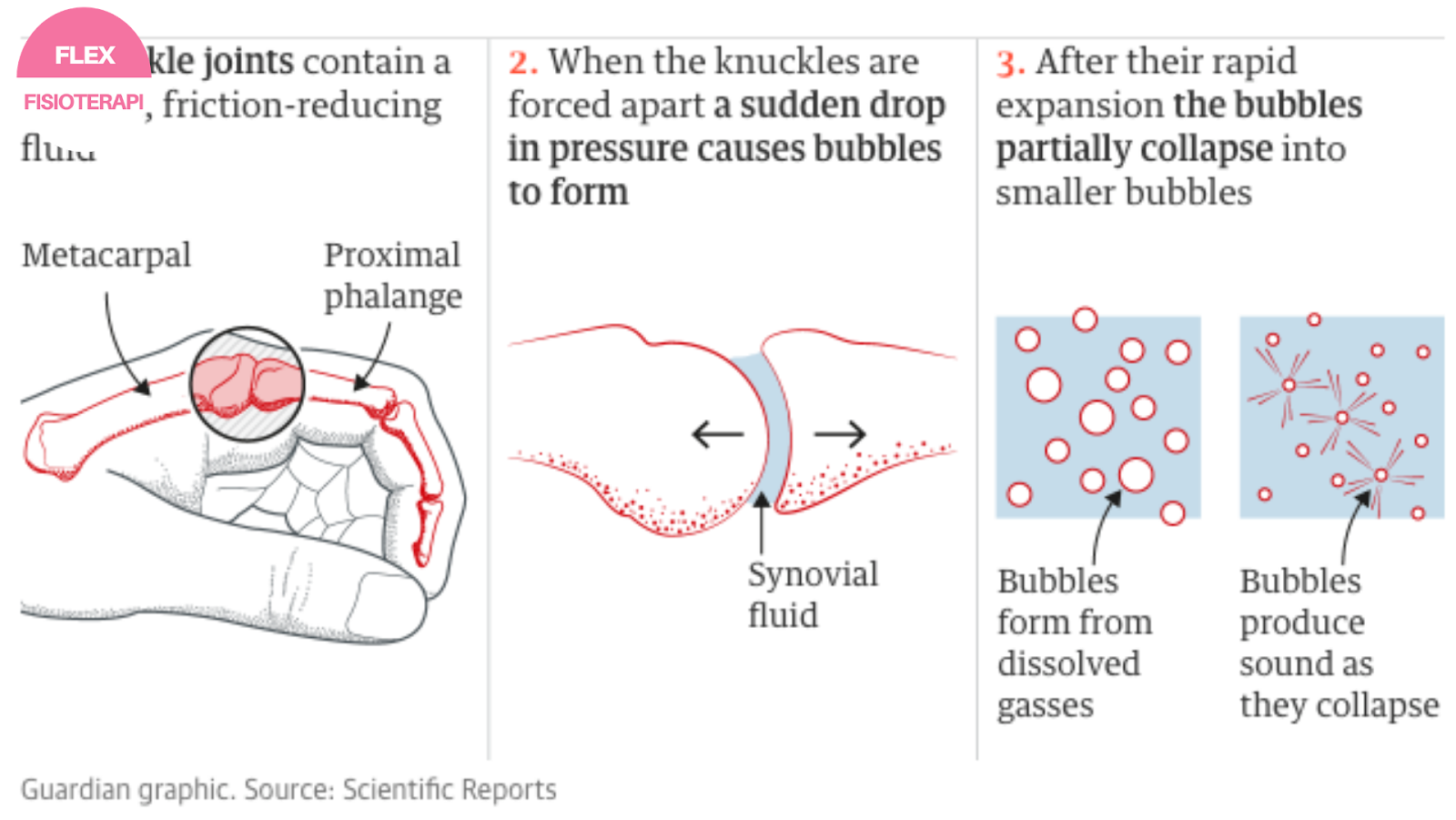Metacarpal Knuckle Cracking: Effects on Cartilage Thickness and Grip Strength
How does habitual knuckle cracking affect metacarpal cartilage thickness. What is the impact of knuckle cracking on grip strength. Are there any long-term effects of frequent joint cracking on hand health. Does knuckle cracking lead to increased risk of arthritis.
The Science Behind Knuckle Cracking: Mechanisms and Myths
Knuckle cracking is a common habit that has long been a subject of fascination and debate. But what exactly happens when we crack our knuckles? The process involves manipulating the finger joints in a way that produces an audible popping sound. This occurs due to the rapid separation of the joint surfaces, creating negative pressure that pulls synovial fluid into the newly created space, forming bubbles that then collapse, producing the characteristic crack.
Despite popular belief, research has shown that knuckle cracking does not directly cause arthritis. However, the long-term effects of this habit on joint health have remained a topic of scientific inquiry. A recent study conducted by Yildizgören et al. sought to shed light on the effects of habitual knuckle cracking on metacarpal cartilage thickness and grip strength.

Study Design: Examining the Impact of Frequent Knuckle Cracking
The research team designed a comparative study involving two groups:
- 35 habitual knuckle crackers (defined as those who crack their joints 5 or more times per day)
- 35 non-crackers matched for age, gender, and body mass index
Participants ranged in age from 19 to 27 years, with an even distribution of males and females (20 males, 15 females) in each group. The study employed two primary measurement techniques:
- Ultrasound imaging to assess metacarpal head (MH) cartilage thickness
- An analog Jamar hand dynamometer to measure grip strength
By comparing these metrics between the two groups, the researchers aimed to determine whether habitual knuckle cracking leads to significant changes in hand physiology and function.
Surprising Findings: Cartilage Thickness in Knuckle Crackers
One of the most intriguing results of the study was the difference in metacarpal head cartilage thickness between habitual knuckle crackers and non-crackers. Contrary to what some might expect, the researchers found that habitual knuckle crackers had thicker MH cartilage in both their dominant and non-dominant hands compared to the control group.
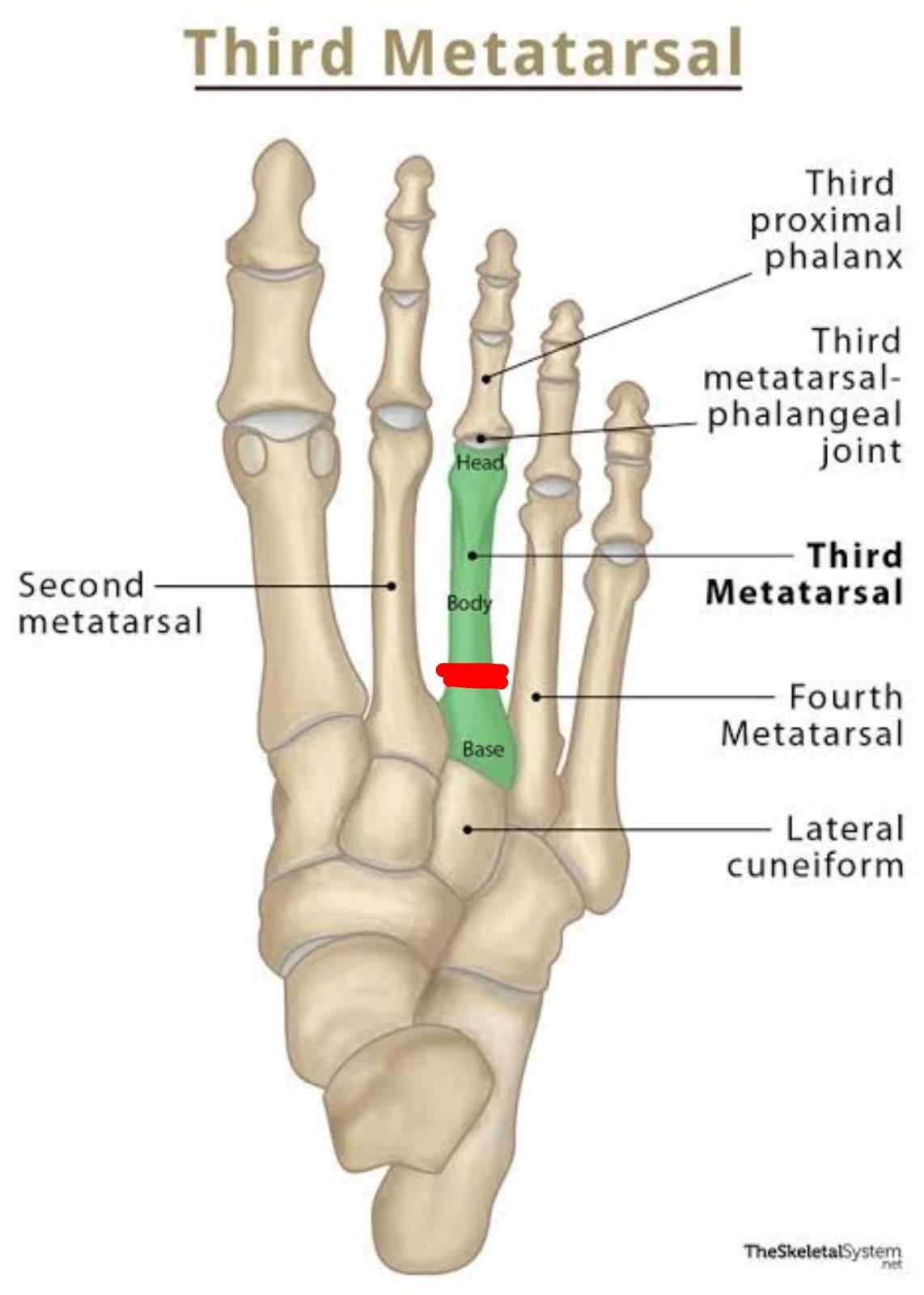
This difference was statistically significant, with p-values of 0.038 for the dominant hand and 0.005 for the non-dominant hand. These findings challenge the notion that knuckle cracking might lead to cartilage degeneration or thinning.
Potential Explanations for Increased Cartilage Thickness
While the study doesn’t provide a definitive explanation for this phenomenon, several hypotheses could account for the increased cartilage thickness in habitual knuckle crackers:
- Adaptive response: The repeated stress of knuckle cracking might stimulate cartilage growth as an adaptive mechanism.
- Increased synovial fluid production: The act of cracking could potentially stimulate the production of synovial fluid, which nourishes and lubricates the cartilage.
- Improved joint mobility: Regular joint manipulation might enhance blood flow and nutrient delivery to the cartilage.
Further research is needed to elucidate the exact mechanisms behind this observation and to determine whether this increased thickness has any long-term implications for joint health.
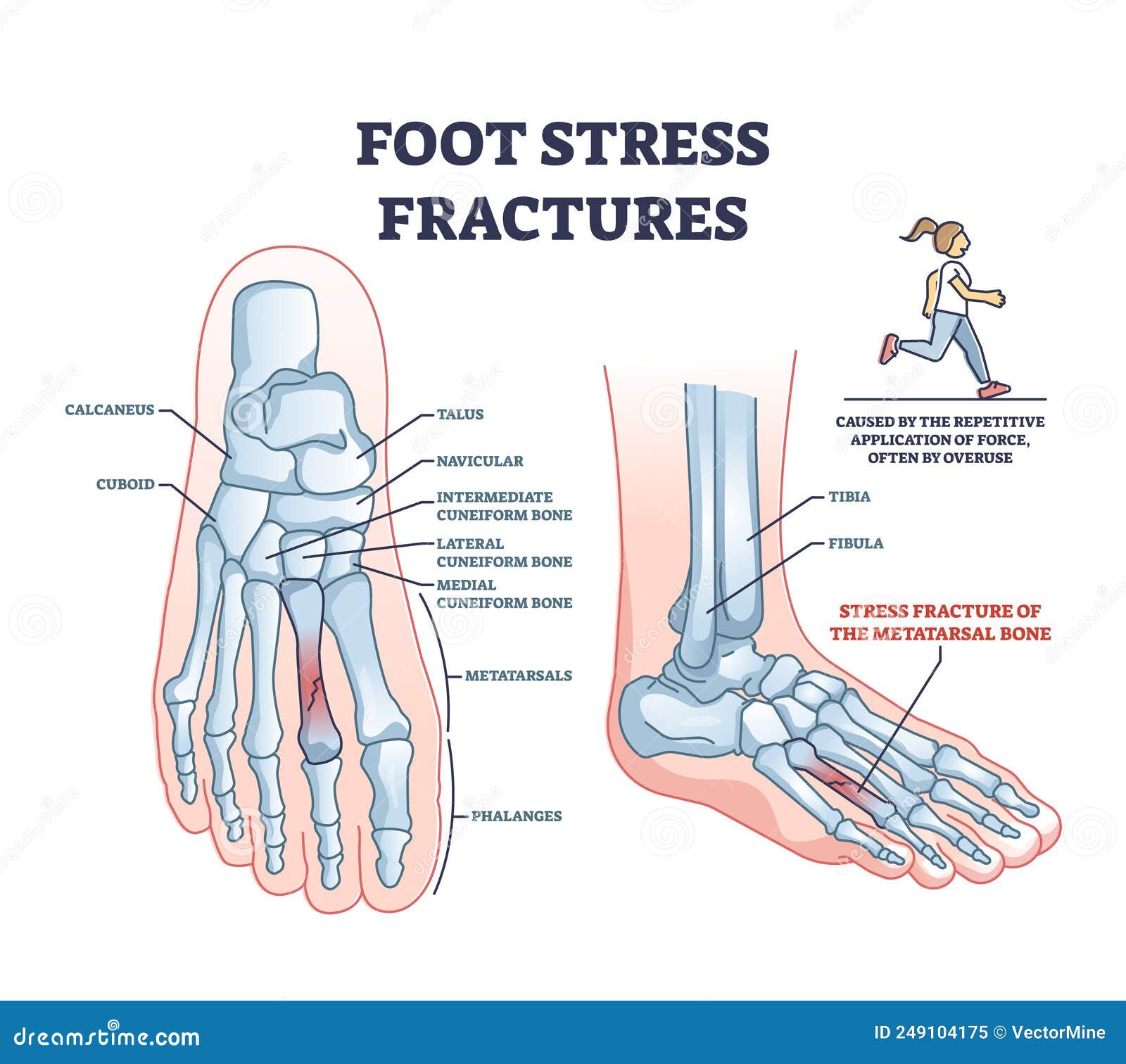
Grip Strength: No Significant Difference Between Groups
Another key aspect of the study was the assessment of grip strength in both habitual knuckle crackers and non-crackers. Interestingly, the researchers found no significant difference in grip strength between the two groups (P>0.05). This suggests that the habit of knuckle cracking does not appear to have a detrimental effect on hand strength, at least in the short to medium term.
This finding is particularly relevant for individuals who may be concerned about the potential negative impacts of knuckle cracking on hand function. It provides reassurance that this common habit is unlikely to compromise grip strength or overall hand performance.
Implications for Hand Function and Daily Activities
The lack of difference in grip strength between knuckle crackers and non-crackers has several implications:
- Occupational considerations: Workers in professions requiring strong grip strength need not worry about knuckle cracking affecting their job performance.
- Sports and athletics: Athletes who habitually crack their knuckles are unlikely to experience reduced hand strength as a result.
- Daily activities: Routine tasks requiring grip strength should not be impacted by knuckle cracking habits.
However, it’s important to note that this study focused on a relatively young population (19-27 years old). Long-term effects over decades of habitual knuckle cracking may still warrant further investigation.

Exploring the Relationship Between Cartilage Thickness and Grip Strength
An intriguing aspect of the study was the exploration of potential correlations between metacarpal head cartilage thickness and grip strength. The researchers found no significant correlation between these two factors in either the knuckle cracking group or the control group (P>0.05).
This lack of correlation suggests that the increased cartilage thickness observed in habitual knuckle crackers does not directly translate to enhanced grip strength. It also implies that other factors, such as muscle mass, neuromuscular coordination, and overall hand health, likely play more significant roles in determining grip strength.
Factors Influencing Grip Strength
While cartilage thickness doesn’t appear to be a major determinant of grip strength, several other factors can influence this important measure of hand function:
- Muscle mass and composition in the forearm and hand
- Neural activation and motor unit recruitment
- Joint flexibility and range of motion
- Overall health status and presence of any underlying conditions
- Age and gender
- Occupational and recreational activities
Understanding these various contributors to grip strength can help individuals and healthcare professionals focus on appropriate interventions to maintain or improve hand function, regardless of knuckle cracking habits.

Long-Term Implications: Does Knuckle Cracking Affect Joint Health?
While this study provides valuable insights into the immediate and short-term effects of habitual knuckle cracking, questions remain about the long-term implications of this behavior on joint health. The increased cartilage thickness observed in knuckle crackers is particularly intriguing and raises several questions about the potential adaptive responses of joint tissues to repeated mechanical stress.
Is the thicker cartilage in habitual knuckle crackers a protective mechanism or a sign of potential future issues? Could the increased thickness lead to altered joint biomechanics over time? These questions highlight the need for longitudinal studies that track individuals over many years to fully understand the long-term effects of knuckle cracking on joint health and function.
Potential Areas for Future Research
To build upon the findings of this study and gain a more comprehensive understanding of the effects of knuckle cracking, future research could focus on:

- Long-term follow-up studies to track changes in cartilage thickness and grip strength over decades
- Investigation of potential differences in joint mobility and range of motion between habitual knuckle crackers and non-crackers
- Examination of synovial fluid composition and production rates in relation to knuckle cracking frequency
- Exploration of potential genetic or environmental factors that might predispose individuals to knuckle cracking habits
- Assessment of joint health using advanced imaging techniques such as MRI to detect subtle changes in joint structure and function
By pursuing these research avenues, scientists can continue to unravel the complex relationship between knuckle cracking and long-term joint health, providing evidence-based guidance for individuals and healthcare professionals alike.
Clinical Implications and Recommendations
The findings of this study have several important clinical implications for healthcare professionals and individuals concerned about the effects of knuckle cracking:

- Reassurance for patients: Clinicians can reassure patients that habitual knuckle cracking does not appear to negatively impact grip strength or lead to cartilage thinning.
- Monitoring cartilage thickness: The observation of increased cartilage thickness in knuckle crackers may warrant regular monitoring in these individuals to track any changes over time.
- Consideration in hand rehabilitation: When designing hand rehabilitation programs, therapists should be aware that knuckle cracking habits may not necessarily indicate compromised hand strength.
- Patient education: Healthcare providers can use this information to educate patients about the current understanding of knuckle cracking effects, dispelling myths and addressing concerns.
While the study suggests that knuckle cracking may not be as harmful as once thought, it’s important to note that excessive or aggressive joint manipulation could potentially lead to other issues, such as ligament laxity or joint instability. Therefore, moderation is key, and individuals should be mindful of any pain or discomfort associated with the habit.

Recommendations for Individuals Who Crack Their Knuckles
For those who habitually crack their knuckles, the following recommendations can help maintain hand health:
- Pay attention to your body: If knuckle cracking causes pain or discomfort, it’s best to avoid the habit and consult a healthcare professional.
- Maintain overall hand health: Engage in regular hand exercises to strengthen muscles and improve flexibility.
- Practice good ergonomics: Ensure proper positioning and support for your hands during work and daily activities to reduce unnecessary stress on the joints.
- Stay hydrated: Proper hydration is essential for maintaining healthy cartilage and synovial fluid in the joints.
- Consider alternative stress-relief techniques: If knuckle cracking is a stress-related habit, explore other methods of relaxation such as mindfulness or stress balls.
By following these recommendations and staying informed about the latest research, individuals can make educated decisions about their knuckle cracking habits while prioritizing overall hand health and function.

Conclusion: Challenging Preconceptions About Knuckle Cracking
The study by Yildizgören et al. provides valuable insights into the effects of habitual knuckle cracking on metacarpal cartilage thickness and grip strength. Contrary to long-held beliefs, the research suggests that frequent knuckle cracking may be associated with increased cartilage thickness without compromising grip strength.
These findings challenge preconceptions about the potential harm of knuckle cracking and open up new avenues for research into joint physiology and adaptation. While the study has its limitations, including a relatively young participant pool and lack of long-term follow-up, it provides a solid foundation for future investigations into this common habit.
As our understanding of knuckle cracking continues to evolve, it’s essential for both healthcare professionals and the general public to stay informed about the latest research. This will enable more accurate patient education and help individuals make informed decisions about their joint health practices.

Ultimately, while this study offers reassurance about the immediate effects of knuckle cracking, it also highlights the complexity of joint biomechanics and the need for continued research to fully understand the long-term implications of this widespread habit. As we await further studies, individuals should listen to their bodies, practice moderation, and prioritize overall hand health through a balanced approach to joint care and function.
Effects of habitual knuckle cracking on metacarpal cartilage thickness and grip strength
. 2017 Feb;36(1):41-43.
doi: 10.1016/j.hansur.2016.09.001.
Epub 2016 Oct 11.
M T Yildizgören
1
, T Ekiz
2
, S Nizamogullari
3
, A D Turhanoglu
3
, H Guler
3
, N Ustun
3
, M Kara
4
, L Özçakar
4
Affiliations
Affiliations
- 1 Mustafa Kemal University Medical School, Department of Physical Medicine and Rehabilitation, Hatay, Turkey. Electronic address: ftr.
 [email protected].
[email protected]. - 2 Elbistan State Hospital, Department of Physical Medicine and Rehabilitation, Kahramanmaraş, Turkey.
- 3 Mustafa Kemal University Medical School, Department of Physical Medicine and Rehabilitation, Hatay, Turkey.
- 4 Hacettepe University Medical School, Department of Physical Medicine and Rehabilitation, Ankara, Turkey.
PMID:
28137441
DOI:
10.1016/j.hansur.2016.09.001
M T Yildizgören et al.
Hand Surg Rehabil.
2017 Feb.
. 2017 Feb;36(1):41-43.
doi: 10.1016/j.hansur.2016.09.001.
Epub 2016 Oct 11.
Authors
M T Yildizgören
1
, T Ekiz
2
, S Nizamogullari
3
, A D Turhanoglu
3
, H Guler
3
, N Ustun
3
, M Kara
4
, L Özçakar
4
Affiliations
- 1 Mustafa Kemal University Medical School, Department of Physical Medicine and Rehabilitation, Hatay, Turkey. Electronic address: [email protected].

- 2 Elbistan State Hospital, Department of Physical Medicine and Rehabilitation, Kahramanmaraş, Turkey.
- 3 Mustafa Kemal University Medical School, Department of Physical Medicine and Rehabilitation, Hatay, Turkey.
- 4 Hacettepe University Medical School, Department of Physical Medicine and Rehabilitation, Ankara, Turkey.
PMID:
28137441
DOI:
10.1016/j.hansur.2016.09.001
Abstract
Joint cracking involves a manipulation of the finger joints resulting in an audible crack. This study aimed to determine whether habitual knuckle cracking (KC) leads to an alteration in grip strength and metacarpal head (MH) cartilage thickness. Thirty-five habitual knuckle crackers (cracking their joints ≥5times/day) (20 M, 15 F, aged 19-27 years) and 35 age-, gender-, and body mass index-matched non-crackers were enrolled in the study. MH cartilage thickness was measured with ultrasound and grip strength was measured with an analog Jamar hand dynamometer. Grip strength was similar between groups (P>0.05). Habitual knuckle crackers had thicker MH cartilage in the dominant and non-dominant hands than those of the controls (P=0.038 and P=0.005, respectively). There was no correlation between MH cartilage thickness and grip strength in both groups (P>0.05). While habitual KC does not affect handgrip strength, it appears to be associated with increased MH cartilage thickness.
This study aimed to determine whether habitual knuckle cracking (KC) leads to an alteration in grip strength and metacarpal head (MH) cartilage thickness. Thirty-five habitual knuckle crackers (cracking their joints ≥5times/day) (20 M, 15 F, aged 19-27 years) and 35 age-, gender-, and body mass index-matched non-crackers were enrolled in the study. MH cartilage thickness was measured with ultrasound and grip strength was measured with an analog Jamar hand dynamometer. Grip strength was similar between groups (P>0.05). Habitual knuckle crackers had thicker MH cartilage in the dominant and non-dominant hands than those of the controls (P=0.038 and P=0.005, respectively). There was no correlation between MH cartilage thickness and grip strength in both groups (P>0.05). While habitual KC does not affect handgrip strength, it appears to be associated with increased MH cartilage thickness.
Keywords:
Cartilage; Craquements articulaires; Force de poigne; Handgrip; Knuckle cracking; Metacarpal; Métacarpien; Ultrasound; Échographie.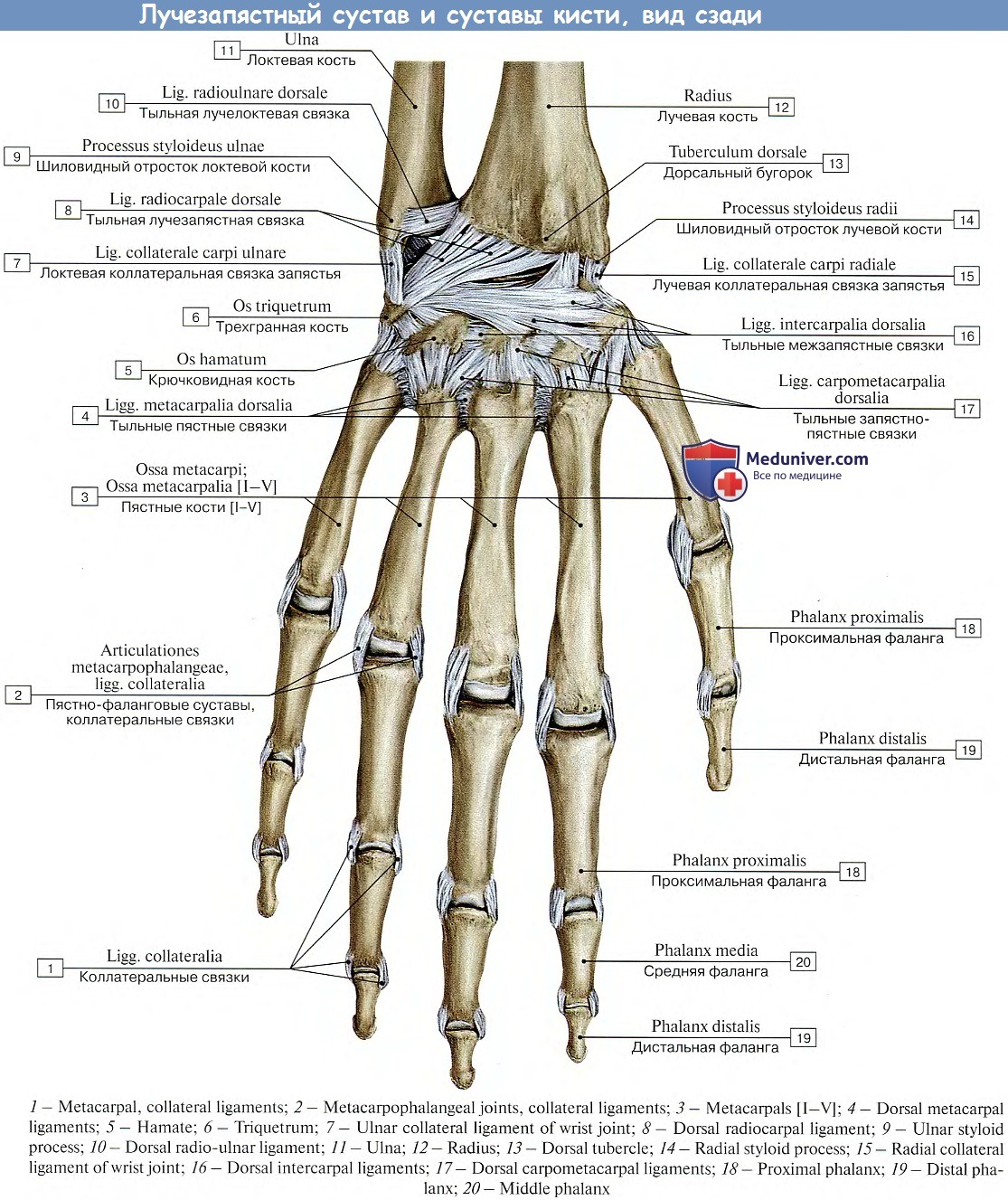
Copyright © 2016 SFCM. Published by Elsevier Masson SAS. All rights reserved.
Similar articles
“Knuckle Cracking”: Can Blinded Observers Detect Changes with Physical Examination and Sonography?
Boutin RD, Netto AP, Nakamura D, Bateni C, Szabo RM, Cronan M, Foster B, Barfield WR, Seibert JA, Chaudhari AJ.
Boutin RD, et al.
Clin Orthop Relat Res. 2017 Apr;475(4):1265-1271. doi: 10.1007/s11999-016-5215-3. Epub 2017 Jan 3.
Clin Orthop Relat Res. 2017.PMID: 28050816
Free PMC article.Effect of habitual knuckle cracking on hand function.
Castellanos J, Axelrod D.
Castellanos J, et al.
Ann Rheum Dis. 1990 May;49(5):308-9. doi: 10.1136/ard.49.5.308.
Ann Rheum Dis. 1990.PMID: 2344210
Free PMC article.
Metacarpal squeezing reduces grip strength.
Erinç S, Uygur E, Akkaya M, Akpınar F.
Erinç S, et al.
Hand Surg Rehabil. 2022 Feb;41(1):37-41. doi: 10.1016/j.hansur.2021.09.005. Epub 2021 Sep 29.
Hand Surg Rehabil. 2022.PMID: 34600131
Let’s get a hand on this: Review of the clinical anatomy of “knuckle cracking”.
Rizvi A, Loukas M, Oskouian RJ, Tubbs RS.
Rizvi A, et al.
Clin Anat. 2018 Sep;31(6):942-945. doi: 10.1002/ca.23243. Epub 2018 Oct 18.
Clin Anat. 2018.PMID: 30080300
Review.
Vitamin D status predicts hand-grip strength in young adult women living in Auckland, New Zealand.
von Hurst PR, Conlon C, Foskett A.
von Hurst PR, et al.

J Steroid Biochem Mol Biol. 2013 Jul;136:330-2. doi: 10.1016/j.jsbmb.2012.11.015. Epub 2012 Dec 7.
J Steroid Biochem Mol Biol. 2013.PMID: 23220545
Review.
See all similar articles
MeSH terms
Anatomy, Shoulder and Upper Limb, Hand Metacarpal Phalangeal Joint – StatPearls
Introduction
The metacarpophalangeal (MP or MCP) joint, also known as “the knuckle,” is formed by the articulation of the metacarpal head and proximal phalanx. This multiaxial joint allows flexion and extension as well as abduction and adduction motions. The MP joint also dynamically coordinates with the interphalangeal (IP) joint to perform thumb opposition and composite finger flexion. The MP joint has implications in many congenital or acquired deformities, sports-related injuries, and degenerative conditions and sequelae.
Structure and Function
The MP joint is responsible for two planes of motion: flexion and extension, as well as abduction and adduction. [1]
[1]
Thumb MP joint
The proximal convex surface of the first metacarpal bone is opposed by the elliptical cavity of the proximal phalanx. Additionally, two sesamoid bones secured by intersesamoid ligaments are present in the palmar aspect of the joint capsule. The first MP joint provides additional flexion to the thumb in opposition, permitting the grasping and contouring objects to facilitate fine motor tasks. Unlike the other digits of the hand, the thumb joint only has one interphalangeal joint which the MP joint coordinates thumb opposition. Compared to the other MP joints of the hand, the MP joint of the thumb has a more restricted range of motion.
Finger MP joints
The finger MP joints have an oval convex metacarpal surface that articulates with a concave, shallow proximal phalangeal surface.[1] Despite their structural similarities, these joints are much less restricted in motion compared to the first MP joint of the thumb. Extensive musculature stabilizes these joints. On the palmar side, the flexor digitorum superficialis, flexor digitorum profundus, lumbricals, interossei, flexor digiti minimi, flexor pollicis longus, and flexor pollicis brevis muscles support the joint.[2][3][4][5] Dorsally, the extensor digitorum, extensor indicis, extensor digiti minimi, extensor pollicis longus, and extensor pollicis brevis muscles reinforce the joint.[6]
On the palmar side, the flexor digitorum superficialis, flexor digitorum profundus, lumbricals, interossei, flexor digiti minimi, flexor pollicis longus, and flexor pollicis brevis muscles support the joint.[2][3][4][5] Dorsally, the extensor digitorum, extensor indicis, extensor digiti minimi, extensor pollicis longus, and extensor pollicis brevis muscles reinforce the joint.[6]
Various ligamentous structures such as the volar plate, longitudinal fibers of the joint capsule, and transverse metacarpal ligaments (superficial and deep) provide additional stability to the joint.
From deep to superficial, the anatomic structures of the MP joint facilitate the overall dynamic function of the MP joint include[3]:
Volar plate
Joint capsule fibers
Deep transverse metacarpal ligament
Flexor digitorum profundus (FDP) tendon
Flexor digitorum superficialis (FDS) tendon
Digital tendon sheath
A1 annular pulley
The volar plate is a short, transverse thickening of the joint capsule that functions to increase overall joint congruence and prevents MP joint hyperextension. [7]
[7]
The joint capsule is a thin, fibrous, and durable network, reinforced by the flexor pollicis brevis and adductor pollicis brevis muscles, the palmar plate, and various collateral ligament connections. The radial and ulnar collateral ligaments arise proximally from their respective sides on the metacarpal bone, spanning the distal and volar sides of the joint to attach on the proximal phalanx.[8] Each collateral ligament has its own proper and accessory ligamentous structures.
The volar fan-shaped accessory ligament attaches to the middle of the metacarpal head and extends to the palmar plate and deep transverse metacarpal ligament which tightens during finger extension. The dorsal, cord-shaped, proper ligament attaches to the metacarpal head and extends to the proximal phalanx base, becoming taut at about 30 degrees of finger flexion. The natatory ligament, also known as the superficial transverse metacarpal ligament, originates distal to the MP joint and runs through the webspace to insert on the proximal phalanx. It functions to resist abduction. The deep transverse metacarpal ligament connects the 2nd-5th metacarpal heads together at the volar plate and provides soft tissue support. Dorsal to this ligament, are the ribbon-shaped sagittal bands that centralize the MP joint and stabilize the extensor tendons in motion.[1]
It functions to resist abduction. The deep transverse metacarpal ligament connects the 2nd-5th metacarpal heads together at the volar plate and provides soft tissue support. Dorsal to this ligament, are the ribbon-shaped sagittal bands that centralize the MP joint and stabilize the extensor tendons in motion.[1]
Embryology
The MP joint forms a cavity in the mesenchyme between developing bones. The mesenchyme also gives rise to the joint capsule and other ligaments that stabilize the joint. The upper limb bud appears around the fourth week of gestation,[9] with the development of the MP joint occurring around 6 to 7 weeks gestation. The sesamoid bones of the first metacarpophalangeal joint do not appear until approximately 12 years of age.
Blood Supply and Lymphatics
The primary blood supply to the hand is through the radial and ulnar arteries. The ulnar artery gives rise to the superficial palmar arch and gives off a deep branch to anastomose with the deep arch. The radial artery gives rise to the deep arch and gives off a superficial branch to anastomose with the superficial arch. This creates an extensive collateral network to prevent ischemia injury. Blood supply to the thumb MP joint may be directly the superficial arch or via a deep branch of the radial artery; the princeps pollicis artery.[10] The arterial supply to the MP joints of the fingers is by branches from adjacent digital arteries.
The radial artery gives rise to the deep arch and gives off a superficial branch to anastomose with the superficial arch. This creates an extensive collateral network to prevent ischemia injury. Blood supply to the thumb MP joint may be directly the superficial arch or via a deep branch of the radial artery; the princeps pollicis artery.[10] The arterial supply to the MP joints of the fingers is by branches from adjacent digital arteries.
The axillary lymph nodes provide lymphatic drainage of the upper limb. The lymphatic system of the upper extremity uses a pathway that originates in the distal fingers tips and palms. The lymphatic system travels on the dorsal aspect of the hand. The lymphatic vessels are typically found just posterior to the cutaneous veins. The lymph drainage continues proximally up the arm, running with the basilic vein until connecting to the lymph nodes in the lateral axillary region. [11]
Nerves
The MP joint receives innervation from the articular branches of the dorsal and palmar digital nerves. The second to fifth MP joints receive innervation from a deep branch of the ulnar nerve that is superficial to the interosseous muscles, but deep and radial to the flexor tendon.[12]
The second to fifth MP joints receive innervation from a deep branch of the ulnar nerve that is superficial to the interosseous muscles, but deep and radial to the flexor tendon.[12]
Muscles
There are several muscles balancing the actions of the MP joint. The extrinsic and intrinsic hand muscles function in flexion and extension respectively. The intrinsic muscles acting on the MP joint include the abductor pollicis brevis, adductor pollicis, dorsal interosseus, palmar interosseus, flexor digiti minimi, flexor pollicis brevis, and lumbrical muscles.[13] The flexor digitorum profundus, flexor digitorum superficialis, flexor pollicis longus, extensor digitorum communis, extensor indicis proprius, and extensor digiti minimi are the extrinsic muscles acting on the MP joint.[13][14]
The flexor digitorum superficialis and flexor digitorum profundus muscles are the flexors of the MP joint. The flexor digitorum superficialis muscle produces more torque at the metacarpophalangeal joint than the flexor digitorum profundus muscle. Compared to the flexor digitorum profundus, the flexor digitorum superficialis muscle crosses fewer joints and is less likely to lose tension as it shortens. The flexor pollicis brevis flexes the thumb MP joint.[13] The flexor digiti minimi muscle flexes the MP joint of the little finger.[13]
Compared to the flexor digitorum profundus, the flexor digitorum superficialis muscle crosses fewer joints and is less likely to lose tension as it shortens. The flexor pollicis brevis flexes the thumb MP joint.[13] The flexor digiti minimi muscle flexes the MP joint of the little finger.[13]
The dorsal interosseous muscles function primarily in MP joint abduction. The abductor pollicis brevis and abductor digiti minimi muscles perform similar functions at the thumb and pinky respectively. The palmar interosseous muscles perform adduction of the MP joint to close spread fingers.[13] The lumbrical muscles are intrinsic muscles that are weak metacarpophalangeal flexors which simultaneously extend the IP joints.
Thumb extension at the MP joint is a function of the extensor pollicis brevis and extensor pollicis longus muscles. Extension of the MP joint of digits 2-5 is a function of the extensor digitorum communis, extensor indicis, and extensor digiti minimi.Specifically, the extensor indicis and extensor digiti minimi muscles extend the MP joints at the index and little fingers respectively. The extensor digitorum communis muscle creates tension over the sagittal bands and pulls them over the proximal phalanx, to create MP joint hyperextension.[13]
The extensor digitorum communis muscle creates tension over the sagittal bands and pulls them over the proximal phalanx, to create MP joint hyperextension.[13]
Physiologic Variants
The literature describes anatomic variation regarding the location of the sesamoid bones of the MP joint. In addition to the thumb MP joint, sesamoid bones are sometimes present at the metacarpal heads of the index and little fingers.[15]
Surgical Considerations
MP Joint Arthritis
MP joint arthritis is a frequent topic in the literature discussing various conditions that ultimately result in mild to end-stage degenerative changes and deformity that can significantly impact a patient’s ability to perform essential daily functions. In milder forms of acquired (e.g., post-traumatic) or degenerative arthritis and deformity, nonoperative measures are the standard, first-line treatment options:
Rest, activity modification
Oral or topic anti-inflammatory medications
Cortisone injections
Splinting
Additionally, the healthcare provider should consider the underlying etiology as this may indicate additional management options. For example, patients with underlying rheumatoid arthritis should obtain a referral to a rheumatologist for specialized medical management to consider starting the patient on disease-modifying antirheumatic drugs (DMARDs).
For example, patients with underlying rheumatoid arthritis should obtain a referral to a rheumatologist for specialized medical management to consider starting the patient on disease-modifying antirheumatic drugs (DMARDs).
Persistent symptoms, synovitis, or swelling despite a 3- to 6-month course of nonoperative interventions warrants consultation with a hand specialist for possible surgical considerations.[16] Considerations for surgery, especially in patients with RA, require a comprehensive evaluation of the patient’s overall health and nutritional status, comorbidities, pharmacologic disease control, and infection risk. Additionally, the degree of bone deformity, which includes an assessment of total bone loss, will help to determine, which the most viable surgical options for the patient.
Metacarpophalangeal Joint Arthroscopy
Metacarpophalangeal joint arthroscopy was first described in 1979,[17] although in general, its use remains limited.
Metacarpophalangeal Joint Arthroplasty
The primary indication for MP joint arthroplasty is severe degenerative arthritis, but the technique also can be used to treat joint deformations from multiple dislocations, subluxations, or cartilage damage.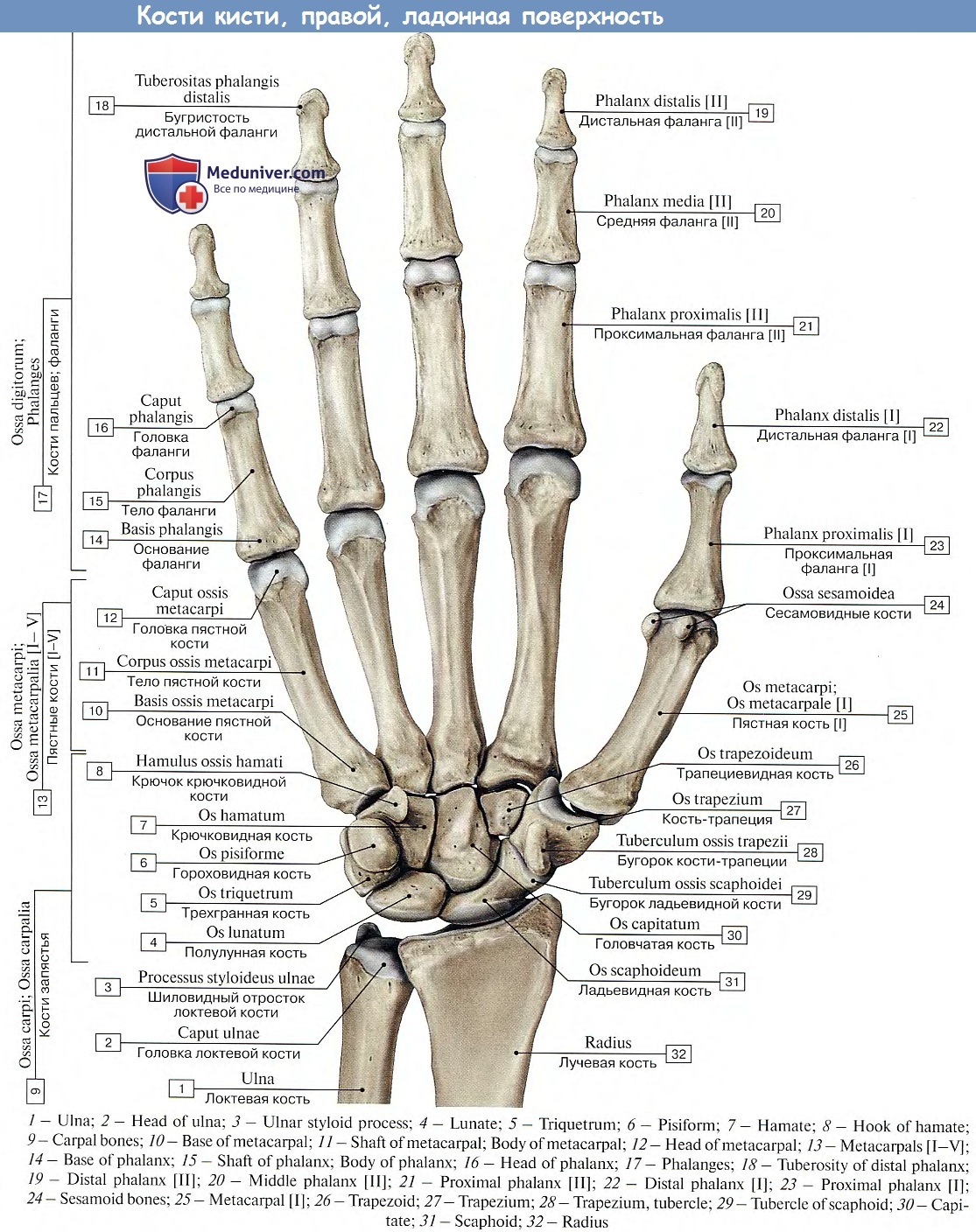
MP joint arthroplasty remains a relatively reliable procedure in terms of its ability to restore function, reduce pain, and improve both function and range of motion[18]. This procedure essentially involves replacement of the deformed joint with a hinged silicon implant, or newer-generation, unconstrained implants designed with either pyrocarbon or metal on polyethylene (MoP), are thought to be most likely to produce good long-term results in patients with pre-existing soft-tissue stability. In patients with end-stage degenerative deformities including compromise of the surrounding soft tissue stabilizing structures, the silicone implants are the favored option. The pyrolytic carbon joint replacements appear to be preferable for patients with well-controlled osteoarthritis or early RA with no or minimal deformity.[16] The procedure begins with a dorsal incision at the metacarpal neck.
The extensor tendons are retracted to expose the joint capsule. The sagittal band and collateral ligaments are released followed by the joint capsule. The metacarpal head is resected and prepared for implantation of the prosthesis. Following insertion, the joint capsule is closed. The patient then is advised to remain in a splint for 12 weeks and start physical therapy at week 6 post-op. [19]
The metacarpal head is resected and prepared for implantation of the prosthesis. Following insertion, the joint capsule is closed. The patient then is advised to remain in a splint for 12 weeks and start physical therapy at week 6 post-op. [19]
Metacarpophalangeal Joint Arthrodesis
Metacarpophalangeal joint arthrodesis, also known as “MP joint fusion,” is commonly used to correct MP joint arthritis in the thumb. This surgical technique usually involves a dorsal incision. The extensor interval is incised longitudinally, and the dorsal capsule is split to expose the joint. Following denuding of the diseased cartilage, fixation is possible through a variety of means, including screws, plates, and wires. Adjuvant allograft or autograft bone grafting is usable in cases of severe bone loss or deformity. The patient requires immobilization for 4 to 6 weeks or until radiographic union occurs.[16]
Clinical Significance
MP Joint Arthritis in patients with Rheumatoid Arthritis
Rheumatoid arthritis is a common autoimmune disease associated with a progressive disability caused by synovial inflammation and hyperplasia that leads to the production of autoantibodies, rheumatoid factor, and anti-citrullinated protein antibodies which attack the MP joint and cause increasing degrees of swelling, pain, and underlying cartilage and osseous destruction.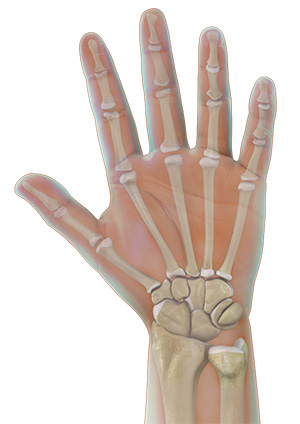 [20][21] Cardiopulmonary disease, psychological disorders, and musculoskeletal complications are also characteristic of this condition.
[20][21] Cardiopulmonary disease, psychological disorders, and musculoskeletal complications are also characteristic of this condition.
MP joint arthritis is a distinguishing feature of rheumatoid arthritis. In RA, the destruction of the MP joint connective tissue leads to an imbalance of the active and passive forces, leading to joint instability, pain, and deformity.[22] A typical early finding of the condition is bilateral symmetric swelling of the MP joints. Pain with passive motion or squeezing of the MP joints is a sensitive test for the joint inflammation that frequently presents with this condition. MP joint dislocation is common and classically presents in the endstage as flexion and ulnar deviation, with dislocation of the joint. Surgical intervention is a patient-centered decision to consider when the deformity severely limits function.[23]
MP Joint Dislocation
Metacarpophalangeal (MP) joint injuries and dislocations of the fingers and thumb commonly occur secondary to direct trauma and/or falls.
A patient with an MP joint dislocation will typically present with a swollen, bruised, and obviously deformed finger. The patient will be focally tender to palpation over the joint itself in addition to the limited ability to move the finger.
Dislocations are described concerning the distal osseous fragment or bone’s position relative to the proximal osseous element. Dorsal dislocations are the most common presentation pattern. In addition, dislocations are further classified as simple versus complex. The former implies a successful closed reduction is achieved by applying axial traction and splinting, while the latter indicates the MP joint dislocation is irreducible by closed means.
The classic description of complex dorsal MP dislocations are:
Proximal phalanx hyperextension
Volar plate rupture and avulsion off of the proximal metacarpal head
Volar plate interposes and impedes closed reduction as it lies on the dorsum of the metacarpal head
Flexor tendons show ulnar displacement; metacarpal head displaces in both radial and volar directions
- Metacarpal head “button-holes” between 4 structures:
Lumbrical
Flexor tendon on the ulnar side of the dislocated digit
Transverse bands of the natatory ligaments (distal)
Superficial transverse ligament (proximal)
Complex MP dislocations, by definition, require open reduction to remove the interposing structures which are impeding reduction.
For the thumb MP joint, anatomical structures that may become trapped include the volar plate, sesamoid bones, bony fracture fragments, and the flexor pollicis longus tendon.[24]
Thumb Collateral Ligament Injury
Thumb collateral ligaments include injuries to the radial collateral ligament (rare) or ulnar collateral ligament (UCL). Thumb UCL injuries can also be described based on existing eponyms in the literature:
Chronic thumb UCL injuries: gamekeeper’s thumb
Acute thumb UCL injury: skier’s thumb
- Stener lesion:
By definition, it implies complete UCL avulsion and displacement above the adductor aponeurosis. The aponeurosis then lies between the UCL and its attachment site, preventing healing
Stener lesions can include thumb UCL avulsion with or without an avulsed osseous attachment
Patients will typically present with a swollen, discolored thumb, with pain that is exacerbated by movement in any direction.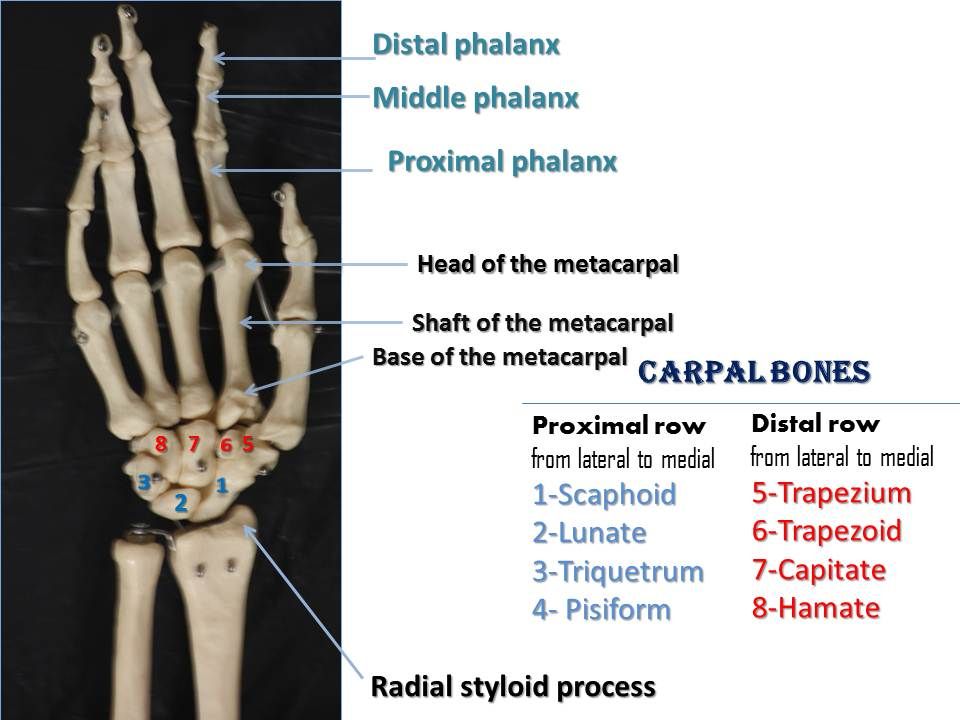 Patients may also present significant weakness of grasp, at the base of the thumb in the first webspace, and wrist pain. The mechanism of injury is commonly hyperextension of the MP joint.
Patients may also present significant weakness of grasp, at the base of the thumb in the first webspace, and wrist pain. The mechanism of injury is commonly hyperextension of the MP joint.
Failure to repair a Stener lesion inevitably results in chronic pain, instability, deformity, weakness, and arthritis. This causes a UCL tear to be managed surgically to prevent long term disability.
Milder injuries and ligamentous sprains (without instability) are amenable to nonoperative management. A thumb spica splint may be utilized until symptoms resolve.
Sagittal Band Rupture
Sagittal band rupture is known as “boxer’s knuckle,” for its tendency to commonly affect members of the pugilist profession. This injury involves a traumatic extensor tendon rupture on the dorsal aspect of the MP joint. Sagittal band rupture often goes unrecognized because the extensor tendon can remain in its normal midline position following the injury.[25] Symptoms range from MP joint pain and edema, due to extensor tendon dislocation. Associated injuries include capsular injury, collateral ligament sprains, and osteochondral fractures. Many acute injuries can be managed nonsurgically using extension splints. Optimal management of chronic or subacute injuries remains unclear. Surgical management involves repair or reconstruction of the radial sagittal band.[25]
Associated injuries include capsular injury, collateral ligament sprains, and osteochondral fractures. Many acute injuries can be managed nonsurgically using extension splints. Optimal management of chronic or subacute injuries remains unclear. Surgical management involves repair or reconstruction of the radial sagittal band.[25]
Review Questions
Access free multiple choice questions on this topic.
Comment on this article.
Figure
Metacarpophalangeal articulation, articulations of digit, Ulnar aspect, Metacarpal, Collateral ligament, Phalanx,. Contributed by Gray’s Anatomy Plates
References
- 1.
Maw J, Wong KY, Gillespie P. Hand anatomy. Br J Hosp Med (Lond). 2016 Mar;77(3):C34-3, C38-40. [PubMed: 26961458]
- 2.
Danda F, Bonaga S, Costa M. [Rupture of the ulnar collateral ligament of the metacarpo-phalangeal joint of the thumb: clinical considerations]. Chir Organi Mov. 1989 Jan-Jun;74(1-2):57-61.
 [PubMed: 2612269]
[PubMed: 2612269]- 3.
Colio SW, Smith J, Pourcho AM. Ultrasound-Guided Interventional Procedures of the Wrist and Hand: Anatomy, Indications, and Techniques. Phys Med Rehabil Clin N Am. 2016 Aug;27(3):589-605. [PubMed: 27468668]
- 4.
Valenzuela M, Varacallo M. StatPearls [Internet]. StatPearls Publishing; Treasure Island (FL): Sep 12, 2022. Anatomy, Shoulder and Upper Limb, Hand Lumbrical Muscles. [PubMed: 30521297]
- 5.
Valenzuela M, Varacallo M. StatPearls [Internet]. StatPearls Publishing; Treasure Island (FL): Jul 25, 2022. Anatomy, Shoulder and Upper Limb, Hand Interossei Muscles. [PubMed: 30521193]
- 6.
Ramage JL, Varacallo M. StatPearls [Internet]. StatPearls Publishing; Treasure Island (FL): Aug 30, 2022. Anatomy, Shoulder and Upper Limb, Wrist Extensor Muscles. [PubMed: 30521226]
- 7.
Hunter-Smith DJ, Slattery PG, Rizzitelli A, Hunter-Smith SR, Fairbank S, Rozen WM, Findlay MW.
 The Dorsal Triangular Fibrocartilage of the Metacarpophalangeal Joint: A Cadaveric Study. J Hand Surg Am. 2015 Jul;40(7):1410-5. [PubMed: 25944552]
The Dorsal Triangular Fibrocartilage of the Metacarpophalangeal Joint: A Cadaveric Study. J Hand Surg Am. 2015 Jul;40(7):1410-5. [PubMed: 25944552]- 8.
Gluck JS, Balutis EC, Glickel SZ. Thumb ligament injuries. J Hand Surg Am. 2015 Apr;40(4):835-42. [PubMed: 25813924]
- 9.
Al-Qattan MM, Yang Y, Kozin SH. Embryology of the upper limb. J Hand Surg Am. 2009 Sep;34(7):1340-50. [PubMed: 19700076]
- 10.
Loukas M, Tubbs S, Louis RG, Apaydin N. Princeps pollicis artery arising from the superficial palmar arch. Singapore Med J. 2009 Nov;50(11):e391-2. [PubMed: 19960153]
- 11.
Suami H, Scaglioni MF. Anatomy of the Lymphatic System and the Lymphosome Concept with Reference to Lymphedema. Semin Plast Surg. 2018 Feb;32(1):5-11. [PMC free article: PMC5891651] [PubMed: 29636647]
- 12.
GRAY DJ, GARDNER E. THE INNERVATION OF THE JOINTS OF THE WRIST AND HAND. Anat Rec. 1965 Mar;151:261-6. [PubMed: 14329188]
- 13.

Bogumill GP. Functional anatomy of the flexor tendon system of the hand. Hand Surg. 2002 Jul;7(1):33-46. [PubMed: 12365048]
- 14.
Koh S, Buford WL, Andersen CR, Viegas SF. Intrinsic muscle contribution to the metacarpophalangeal joint flexion moment of the middle, ring, and small fingers. J Hand Surg Am. 2006 Sep;31(7):1111-7. [PubMed: 16945712]
- 15.
Chen W, Cheng J, Sun R, Zhang Z, Zhu Y, Ipaktchi K, Zhang Y. Prevalence and variation of sesamoid bones in the hand: a multi-center radiographic study. Int J Clin Exp Med. 2015;8(7):11721-6. [PMC free article: PMC4565393] [PubMed: 26380010]
- 16.
Rizzo M. Metacarpophalangeal joint arthritis. J Hand Surg Am. 2011 Feb;36(2):345-53. [PubMed: 21276901]
- 17.
Chen YC. Arthroscopy of the wrist and finger joints. Orthop Clin North Am. 1979 Jul;10(3):723-33. [PubMed: 460845]
- 18.
Aujla RS, Sheikh N, Divall P, Bhowal B, Dias JJ. Unconstrained metacarpophalangeal joint arthroplasties: a systematic review.
 Bone Joint J. 2017 Jan;99-B(1):100-106. [PubMed: 28053264]
Bone Joint J. 2017 Jan;99-B(1):100-106. [PubMed: 28053264]- 19.
Swanson AB, Herndon JH. Flexible (silicone) implant arthroplasty of the metacarpophalangeal joint of the thumb. J Bone Joint Surg Am. 1977 Apr;59(3):362-8. [PubMed: 849948]
- 20.
Scott DL, Wolfe F, Huizinga TW. Rheumatoid arthritis. Lancet. 2010 Sep 25;376(9746):1094-108. [PubMed: 20870100]
- 21.
McInnes IB, Schett G. The pathogenesis of rheumatoid arthritis. N Engl J Med. 2011 Dec 08;365(23):2205-19. [PubMed: 22150039]
- 22.
Bielefeld T, Neumann DA. The unstable metacarpophalangeal joint in rheumatoid arthritis: anatomy, pathomechanics, and physical rehabilitation considerations. J Orthop Sports Phys Ther. 2005 Aug;35(8):502-20. [PubMed: 16187511]
- 23.
Goldfarb CA, Dovan TT. Rheumatoid arthritis: silicone metacarpophalangeal joint arthroplasty indications, technique, and outcomes. Hand Clin. 2006 May;22(2):177-82. [PubMed: 16701130]
- 24.

Izadpanah A, Wanzel K. Late presentation of a complete complex thumb metacarpophalangeal joint dislocation: A case report. Can J Plast Surg. 2011 Winter;19(4):139-42. [PMC free article: PMC3269199] [PubMed: 23204885]
- 25.
Kleinhenz BP, Adams BD. Closed Sagittal Band Injury of the Metacarpophalangeal Joint. J Am Acad Orthop Surg. 2015 Jul;23(7):415-23. [PubMed: 26111875]
Disclosure: Lauren Okafor declares no relevant financial relationships with ineligible companies.
Disclosure: Margaret Sinkler declares no relevant financial relationships with ineligible companies.
Disclosure: Matthew Varacallo declares no relevant financial relationships with ineligible companies.
Proximal phalanx – e-Anatomy – IMAIOS
SUBSCRIBE
SUBSCRIBE
Definition
English
Portugues
No definition for this anatomical structure yet
Definition for:
English
Portugues
I consent to the assignment of the rights associated with my participation in the project, in accordance with the Terms and Conditions of Use of the site.
I agree to the assignment of the rights associated with my participation in the project, in accordance with the Terms and conditions of use of the site.
Gallery
Comparative anatomy of animals
- Proximal phalanx
- Proximal phalanx
Translations
IMAIOS and certain third parties use cookies or similar technologies, in particular for audience measurement. Cookies allow us to analyze and store information such as your device characteristics and certain personal data (for example, IP addresses, navigation, usage and location data, unique identifiers). This data is processed for the following purposes: to analyze and improve the user experience and/or our content, products and services, to measure and analyze the audience, to interact with social networks, to display personalized content, to measure the performance and attractiveness of content. For more information, please see our privacy policy: privacy policy.
Cookies allow us to analyze and store information such as your device characteristics and certain personal data (for example, IP addresses, navigation, usage and location data, unique identifiers). This data is processed for the following purposes: to analyze and improve the user experience and/or our content, products and services, to measure and analyze the audience, to interact with social networks, to display personalized content, to measure the performance and attractiveness of content. For more information, please see our privacy policy: privacy policy.
You can give, withdraw or withdraw your consent to data processing at any time using our cookie settings tool. If you do not agree to the use of these technologies, this will be regarded as a refusal of the legitimate interest storage of any cookies. To consent to the use of these technologies, click the “Accept all cookies” button.
Analytical cookies
These cookies are designed to measure the audience: site traffic statistics help improve the quality of its work.
- Google Analytics
Early diagnosis of hand injury
The hand includes the structures of the palm and fingers. The metacarpal bones are 5 long bones of the hand located between the wrist and fingers. They form the palm and are visible through the skin on the back of the hand. Each metacarpal corresponds to a finger and consists of a base, a shaft or body, and a head. The first metacarpal is slightly thicker and shorter, has the most mobility and can move on its own. The 2nd-5th metacarpals move with each other and are similar in size and shape:
- thumb, metacarpal: the thickest and shortest metacarpal, moves with the trapezium
- index, metacarpal: the longest metacarpal with the largest base, which connects to the trapezium, trapezius and metacarpal bone
- medial, metacarpal: articulates with metacarpal
- innominate metacarpal: articulates with third metacarpal and concave face
- 5 metacarpal or little finger: the smallest metacarpal articulates with the hamate.

The bones of the fingers are made up of 14 narrow bones called phalanges. Each of the 4 fingers consists of a proximal, middle and distal phalanx:
- proximal phalanx. The proximal phalanx, the largest of the phalanges, articulates with the metacarpal and middle phalanx
- middle or intermediate phalanx. Middle phalanx articulating with proximal phalanx and distal phalanx
- distal phalanx. The distal phalanx supports the nail and the sensitive skin of the fingertip and forms an articulation with the middle phalanx
The thumb has only proximal and distal phalanges.
The joints of the fingers allow a variety of movements, for example:
- metacarpophalangeal joint connects the metacarpal bone to the proximal phalanx and provides compression, grip and multidirectional movement of the finger
- proximal interphalangeal joint – the connection between the proximal and middle phalanges, which allows the finger to flex and extend
- the distal interphalangeal joint is responsible for the movement of the fingertip near the nail bed
- the trapeziocarpal joint is the thumb joint, which is more specialized and has the greatest mobility and flexibility
- metacarpophalangeal joint connects the metacarpal and proximal phalanx and is used to grip
- the interphalangeal joint is responsible for the movements of the fingertip near the nail layer.

Mobility of the hand and fingers is provided by tissues of the tendon, muscles and ligaments. Both bone and soft tissues of the hand are subject to injuries of a traumatic and age-related nature.
What should be done for early diagnosis of a hand injury? The patient, first of all, needs to make an appointment with an orthopedist and have an X-ray or MRI of the hand.
After the initial appointment, the doctor may prescribe additional examinations:
- CT brushes
- Ultrasound of soft tissues.
Types of damage to the hand
Claw brush
The claw hand has a noticeable curve across all fingers, resulting in a hook-shaped hand. The disease can damage the fingers on one or both hands. Patients with a similar diagnosis cannot perform grasping functions. The claw-shaped brush in most cases is provoked by injuries. Another cause of the disease can be diabetic nephropathy.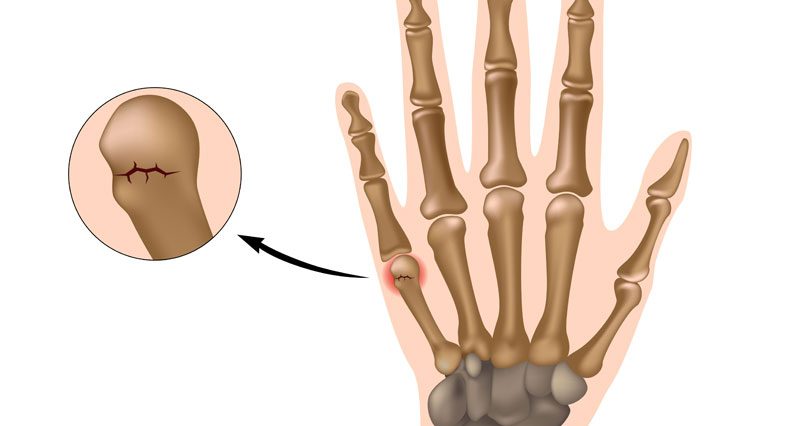
Median nerve palsy
Median nerve palsy is usually caused by damage to the wrist or forearm. In addition, injury can impair muscle function, leading to muscle atrophy. The median nerve runs the entire length of the arm, starting from the shoulder. It runs through the forearm and ends at the wrist. The nerve provides the motor function of the forearm, as well as the sensory function of the wrist, thumb, middle, index and ring fingers.
Osteoarthritis of the hand
Osteoarthritis of the hand, also known as degenerative joint disease, is the most common form of arthritis in the joints. Osteoarthritis most often develops with age. Inflammation and damage to the joint causes bony changes, deterioration of tendons and ligaments, and destruction of cartilage, leading to hand pain, swelling, and deformity of the fingers.
Joint hypermobility syndrome
Joint hypermobility syndrome is a condition where the patient has very flexible joints and this causes aching joint pain. This disease usually affects children and young adults and often gets better as they get older. Joint hypermobility syndrome can be inherited. Usually the joints become too elastic because the ligaments that are supposed to make them stronger and support them are weakened. This weakness occurs because the patient’s ligament-strengthening collagen differs in structure from normal collagen. Most experts agree that joint hypermobility syndrome is part of a spectrum of hypermobility disorders such as Ehlers-Danlos syndrome.
This disease usually affects children and young adults and often gets better as they get older. Joint hypermobility syndrome can be inherited. Usually the joints become too elastic because the ligaments that are supposed to make them stronger and support them are weakened. This weakness occurs because the patient’s ligament-strengthening collagen differs in structure from normal collagen. Most experts agree that joint hypermobility syndrome is part of a spectrum of hypermobility disorders such as Ehlers-Danlos syndrome.
Fracture of the bone of the hand
Fracture of the hand bone is a medical term used to define the partial or complete destruction of bone tissue. In most cases, damage is caused by falls, sports injuries, fights, and car accidents. When a bone is broken, a splint, plaster or bandage is applied to the patient, which helps restore the integrity of the bone. In particularly severe situations, surgical intervention and the installation of fixing structures may be required.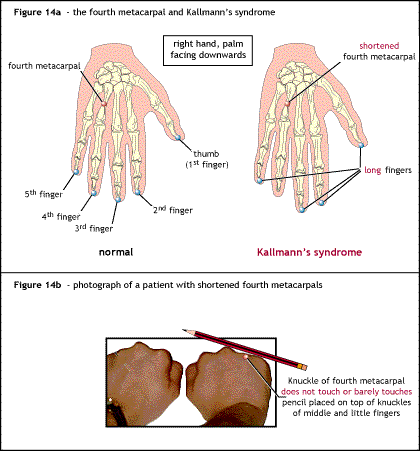 The recovery time depends on the complexity of the damage, as well as the factors that provoked it. The specific type of fracture will be diagnosed after the traumatologist conducts a physical examination and examines the results of the research.
The recovery time depends on the complexity of the damage, as well as the factors that provoked it. The specific type of fracture will be diagnosed after the traumatologist conducts a physical examination and examines the results of the research.
Osteoporosis
Osteoporosis is a disease in which bones become weak, brittle and more likely to fracture. This condition develops slowly over several years and is often only diagnosed when a fracture occurs as a result of a fall or injury. Bone loss is a normal aging process, but some patients lose it much faster than usual. This can lead to osteoporosis and an increased risk of damage to the bones of the wrist, fingers, and hands. Women are more at risk of developing osteoporosis than men because hormonal changes during menopause directly affect bone density. After menopause, the level of the sex hormone estrogen drops significantly, which can lead to the rapid development of osteoporosis.
Bruised hand
Bruises usually result from a direct blow to the hand. An injury can cause a bruise or hematoma, a type of bruise in which blood pools under the skin and damages tissue. Severe bruising leads to myositis ossificans – the formation of bone inside the muscle.
An injury can cause a bruise or hematoma, a type of bruise in which blood pools under the skin and damages tissue. Severe bruising leads to myositis ossificans – the formation of bone inside the muscle.
Bone, like skin and soft tissues, can be bruised. But, unlike skin damage, a much greater impact force is required to bruise a bone. In this case, accumulations of blood are formed on the surface of the bone tissue, indicating the presence of an injury. Violation of the structural integrity does not occur. Despite the fact that a bruise is considered a less serious type of injury, you should not put off going to the doctor. As soon as possible, contact a traumatologist to specify the problem and begin its treatment.
Dislocation of the wrist joint
Dislocation of the hand joint is an injury in which the bone slips out of its normal position in the joint and limits its mobility. When ligaments and muscles are damaged, the bone often comes out of the groove, causing pain in the cyst or fingers. The degree of dislocation determines whether it is called sprain or dislocation. Symptoms of a dislocation include pain, joint instability, swelling of the hand, and displacement of the joint.
The degree of dislocation determines whether it is called sprain or dislocation. Symptoms of a dislocation include pain, joint instability, swelling of the hand, and displacement of the joint.
Sprain and tear of the ligaments of the hand
Stretching or tearing of the connective tissue leads to severe pain and limited mobility of the hand. Often, sprain is the result of traumatic injury to the hand.
Muscle strain and tear
Damage to the muscles of the hand occurs when the muscle fibers are overstretched. In severe cases, the muscles are torn. The patient can tear a muscle in the hand while lifting a heavy object or engaging in heavy athletic activity. Muscle strains are very common. They can also be the result of overuse.
Rhabdomyolysis
Rhabdomyolysis is a rare, life-threatening condition that occurs when muscle fibers break down. Damage usually occurs as a result of overexertion and intense physical activity. It is most common in endurance athletes.
It is most common in endurance athletes.
Sprain and rupture of the tendons of the hand
Stretching or rupture of tendon tissue results in severe pain and limited range of motion of the hand. Often, sprain is the result of traumatic injury to the hand.
Rupture of cartilage
Injury to the joint of the hand can lead to cartilage damage. Cartilage tears can often occur with sprains. Treatment may include movement restriction and rest. Surgery may be required to repair a cartilage tear.
Tendinitis, tendinosis and tenosynovitis
Tendonitis of the tendon occurs when the tendons become inflamed, usually due to repetitive activity, overuse, or aging. Tendinosis is a chronic disease that occurs when the collagen in the tendon accumulates many broken fibers within the tendon, which weakens the tendon and degrades its structure. Most often it occurs against the background of tendonitis. Tenosynovitis occurs when tendinitis is combined with inflammation of the tendon sheath. For example, de Quervain’s tenosynovitis causes swelling of the tendons in the thumb. It can be the result of overuse, repetitive seizure, or inflammatory conditions such as arthritis. A trigger finger occurs when the finger of the hand gets stuck in a bent position. Most often, inflamed and irritated tendons cause this condition.
For example, de Quervain’s tenosynovitis causes swelling of the tendons in the thumb. It can be the result of overuse, repetitive seizure, or inflammatory conditions such as arthritis. A trigger finger occurs when the finger of the hand gets stuck in a bent position. Most often, inflamed and irritated tendons cause this condition.
Synovitis
Synovitis is a severe inflammation of the joints, in which the inflammation mainly affects the synovial membrane. Some types of autoimmune diseases, such as rheumatoid arthritis, juvenile arthritis, systemic lupus erythematosus, and psoriatic arthritis, can affect the synovial membrane. Synovial inflammation can also be caused by tuberculosis, trauma, or gout.
Hand tremor
Tremor is a motor disorder that is manifested by involuntary rhythmic fluctuations in various parts of the body, arising from stereotypically repeated contraction and relaxation of the muscles. This shaking is uncontrollable. Tremor usually affects the hands and arms, but can also affect the head and other parts of the body.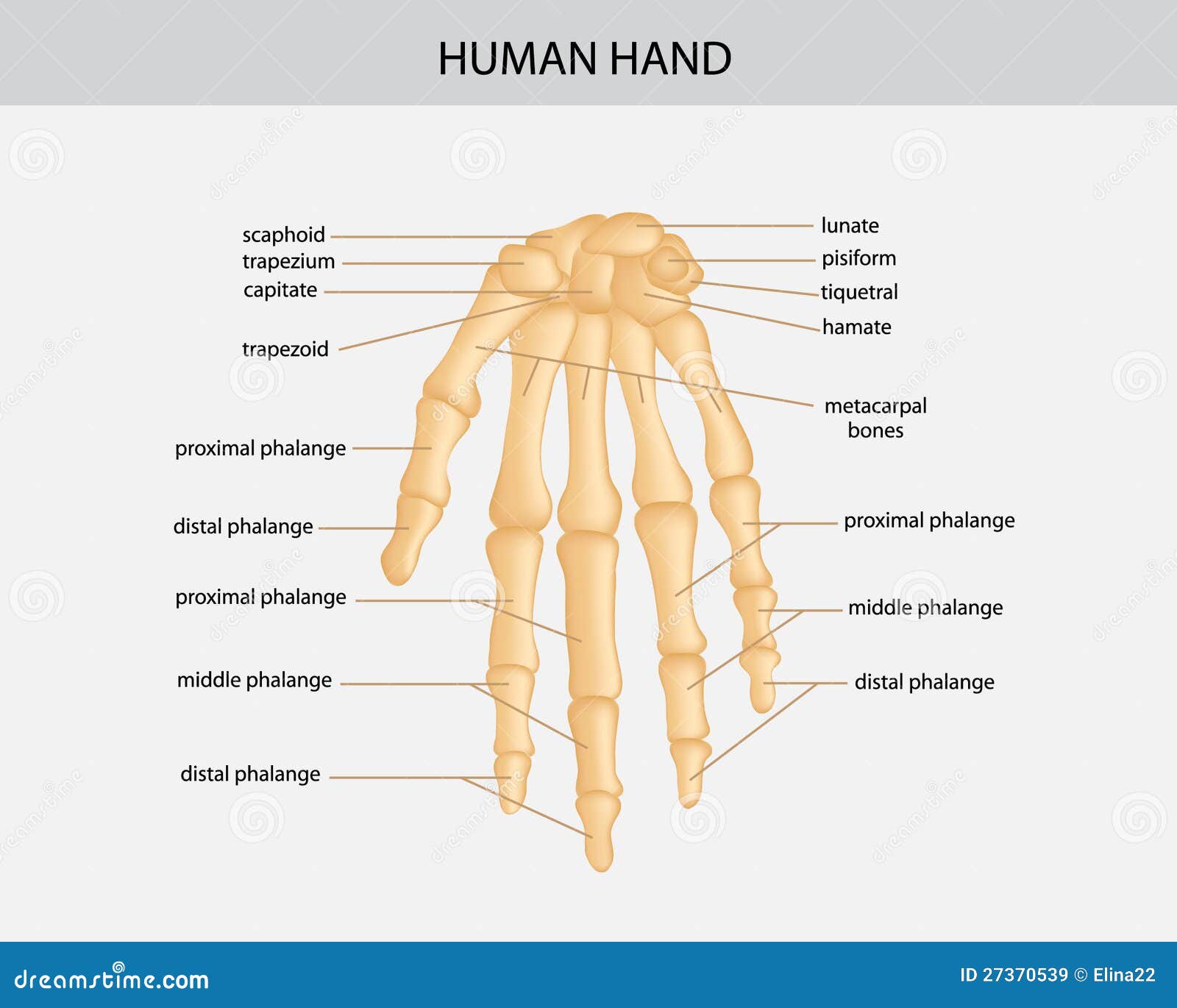 In its advanced stages, this condition seriously interferes with some of life’s most basic tasks. Many patients also experience feelings of embarrassment or anxiety due to the symptoms of this hand lesion.
In its advanced stages, this condition seriously interferes with some of life’s most basic tasks. Many patients also experience feelings of embarrassment or anxiety due to the symptoms of this hand lesion.
Leading doctors in St. Petersburg
Ibragimov Dmitry Sergeevich
Orthopedist, Ultrasound Doctor, Vertebrologist, Traumatologist, Surgeon
Reviews: 588
Rating: 4.9 out of 5
Experience:
90 003 since 1999
Receptionist:
MC Longa Vita , MC Consilium Med
Appointment
Abzianidze Alexey Vadimovich
Orthopedist
Reviews: 640
Rating: 5.0 out of 5
Experience:
since 2001
Clinic Riorit, Outpatient Department No. 41
Appointment
Aliev Murad Ramazanovich
Orthopedist, Traumatologist
Reviews: 594
Rating: 4.9 out of 5
Experience:
since 2009
90 252
Receptionists:
clinic Medicenter, clinic Poem Zdorovya
Appointment
Angelcheva Tatyana Avramovna
Orthopedist, Traumatologist
Reviews: 633
Rating: 4.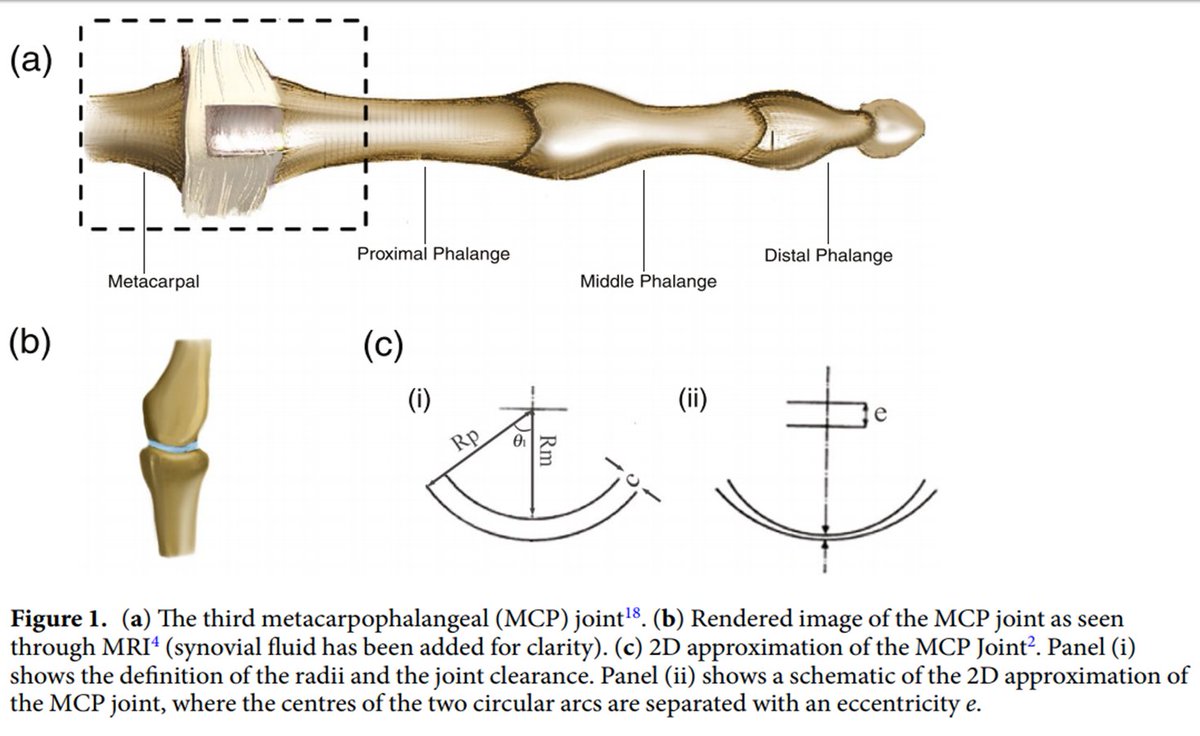 8 out of 5
8 out of 5
Experience:
since 2015
Receiving:
SM- Clinic Udarnikov
Appointment
Ilya Antonov
Orthopedist, Traumatologist
Reviews: 619
Rating: 5.0 out of 5
Experience:
since 2015
Receptionist:
Marshal Zakharov SM-Clinic
Appointment appointment
Akhmedov Kazali Muradovich
900 03 Orthopedist, Traumatologist
Reviews: 597
Rating: 5.0 out of 5
Experience:
since 2018
Receptionists:
SM-Clinic Malaya Balkanskaya, SM-Clinic Dunaisky, CMRT Petrogradsky
Appointment 900 04 Baizhanov Abylkhair
Orthopedist, Traumatologist
Reviews: 626
Rating: 4.7 out of 5
Experience:
since 2017
Receptionist:
clinic Medicenter
Appointment appointment
Belousov Evgeny Ivanovich
Orthopedist, Traumatologist, Surgeon
Reviews: 631
Rating: 4. 8 out of 5
8 out of 5
Experience:
since 1990
Receptionist:
SM-Clinic Udarnikov
Appointment
Bizyukov Oleg Valerievich
Orthopedist, Traumatologist
Reviews: 633
Rating: 5.0 out of 5 90 004
Experience:
since 1998
Receptionist:
Clinic March , VCERM im. Nikiforova
Appointment
Borisova Olga Mikhailovna
Orthopedist, Traumatologist, Surgeon
Reviews: 631
Rating: 4.8 of 5
Experience:
since 2007
Receptionist:
SM-Clinic Danube
Appointment appointment
Causes of damage to the hand
The hands are severely overused. Wear and tear of tissues and small joints occurs much earlier than in other large joints.
Calcium is essential for the formation of strong and healthy bones. Calcium deficiency can lead to weakened bones, increasing the risk of comorbidities such as osteoporosis. Calcium deficiency can be replenished by eating dairy products, broccoli, some leafy green vegetables, and beans
Calcium deficiency can be replenished by eating dairy products, broccoli, some leafy green vegetables, and beans
Falling estrogen levels during menopause can affect the hydration of joints and tendons, causing cracked fingers, stiffness, and joint inflammation.
Hand injury symptoms
Hand injuries are accompanied by the following common symptoms:
- pain in various areas of the hand, from the wrist to the fingers
- tingling or numbness in the hand and fingers
- painful, inflamed swelling in the hands
- hand muscle weakness
- stiffness of the hand and fingers
- change in color or temperature of the skin of the hand.
Diagnosis of hand injuries – examinations and tests
Mild deformities and dislocations of the hand can usually be diagnosed based on a medical history, including a review of symptoms and how the injury occurred, as well as a physical examination by an orthopedic trauma physician. In cases of more serious damage, especially with weakness or loss of function of the joint, may be prescribed:
In cases of more serious damage, especially with weakness or loss of function of the joint, may be prescribed:
- X-ray or CT scan of hand to rule out bone fracture
- MRI of the hand to evaluate soft tissue and degenerative cartilage damage.
Treatment
Hand injury treatment will depend on the specific condition, but all procedures will be aimed at restoring functionality. Some injuries can be treated with rest, while other conditions that cause limb deformities will require surgery.
Prophylaxis
Pathologies of the hands can be prevented with regular exercise that relaxes the joints and muscles. These exercises are based on the movement of the wrist and the stretching of the fingers. Physical therapy is used to relax the arm, get rid of stiffness and increase flexibility. A diet rich in calcium, vitamin D, and omega-3 fats also helps maintain healthy bones and joints in the hand.
Author: Abzianidze Alexey Vadimovich
Specialization: Orthopedist, Traumatologist
Appointment appointment: RIORIT Medical Center
Share:
List of scientific literature
- Sokov LP Diagnosis and treatment of bone fractures: textbook.





 [PubMed: 2612269]
[PubMed: 2612269] The Dorsal Triangular Fibrocartilage of the Metacarpophalangeal Joint: A Cadaveric Study. J Hand Surg Am. 2015 Jul;40(7):1410-5. [PubMed: 25944552]
The Dorsal Triangular Fibrocartilage of the Metacarpophalangeal Joint: A Cadaveric Study. J Hand Surg Am. 2015 Jul;40(7):1410-5. [PubMed: 25944552]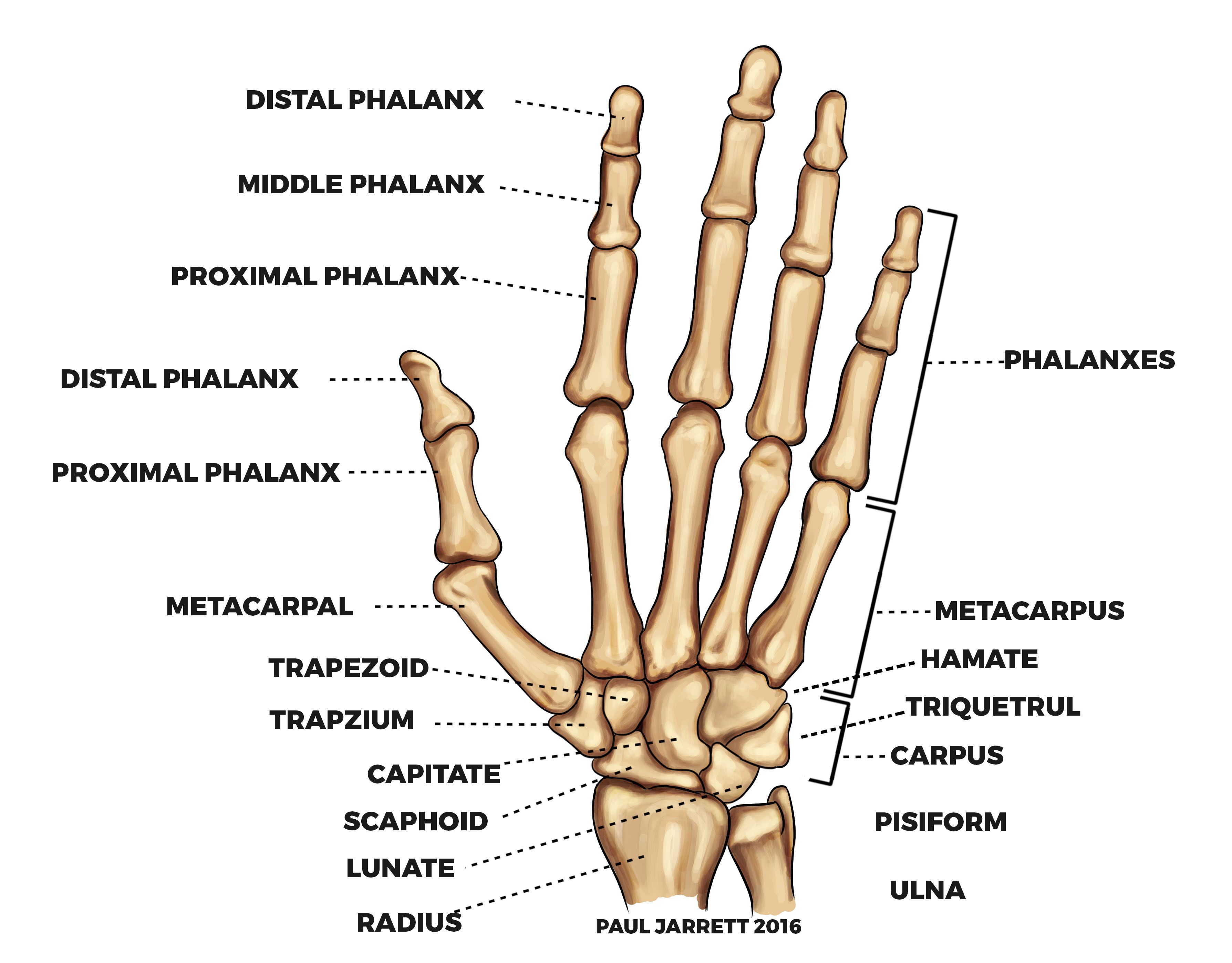
 Bone Joint J. 2017 Jan;99-B(1):100-106. [PubMed: 28053264]
Bone Joint J. 2017 Jan;99-B(1):100-106. [PubMed: 28053264]
